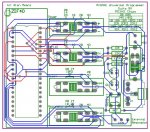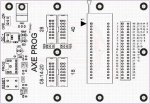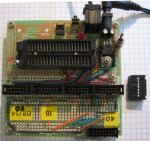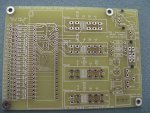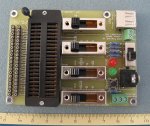I have been playing with various PICAXE chips for a few years now and have usually been programming them while in place on-board, or using a home-built programmer (on an experimenters board using multiple ZIF sockets).
It's been bugging me for a while that I couldn't find an all-in-one board that would suit everything from 8 pin through to 40 pin PICAXE, so over the weekend, I designed this (see attachment for PCB overlay). It measures 80mm x 70mm and has a single 40-pin ZIF socket to fit any 5V PICAXE chip.
There are 4x four-throw slide switches to select the chip used. Each switch is for a "function" (Power, Serial Communication, Reset, Resonator). I was initially going to use a rotary switch but they are too bulky and didn't think there would be too much of a problem having multiple switches as long as they're laid out neatly.
Other items :
- Terminal block to screw in any external resonator
- Tactile pushbutton for reset
- Standard 3.5mm stereo plug for the AXE027 cable
- LED for indicating circuit power
- LED which is lit during program download
I did create another design which was the same as this one but above all these components, had a 9V battery PCB clip on board with a 78L05 and decoupling caps, but that was before I remembered the current rating of the PP3 9V batteries are quite low and wasn't sure how long a 9V battery would last in this application.
I haven't yet fabricated the board (or tested of course), but I thought I'd get feedback first to see if I could improve it. Comments?
It's been bugging me for a while that I couldn't find an all-in-one board that would suit everything from 8 pin through to 40 pin PICAXE, so over the weekend, I designed this (see attachment for PCB overlay). It measures 80mm x 70mm and has a single 40-pin ZIF socket to fit any 5V PICAXE chip.
There are 4x four-throw slide switches to select the chip used. Each switch is for a "function" (Power, Serial Communication, Reset, Resonator). I was initially going to use a rotary switch but they are too bulky and didn't think there would be too much of a problem having multiple switches as long as they're laid out neatly.
Other items :
- Terminal block to screw in any external resonator
- Tactile pushbutton for reset
- Standard 3.5mm stereo plug for the AXE027 cable
- LED for indicating circuit power
- LED which is lit during program download
I did create another design which was the same as this one but above all these components, had a 9V battery PCB clip on board with a 78L05 and decoupling caps, but that was before I remembered the current rating of the PP3 9V batteries are quite low and wasn't sure how long a 9V battery would last in this application.
I haven't yet fabricated the board (or tested of course), but I thought I'd get feedback first to see if I could improve it. Comments?
Attachments
-
37.2 KB Views: 146
Last edited:


